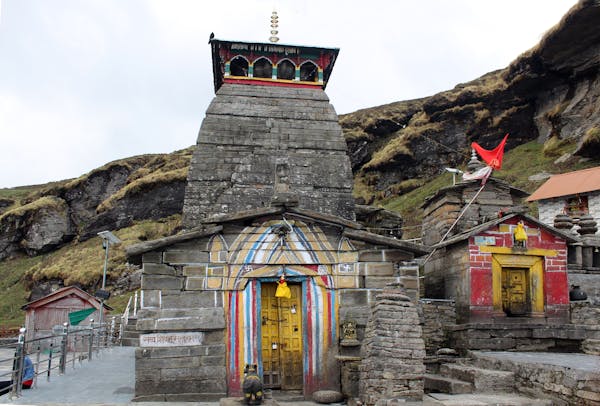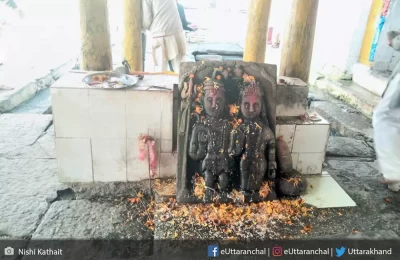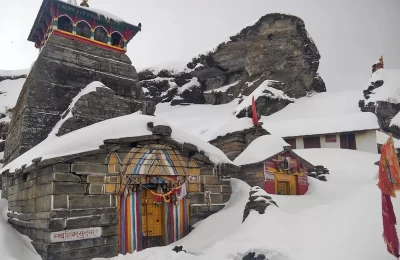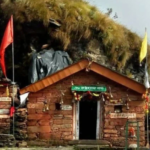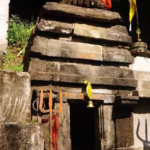

Tungnath Temple – Ashu Tour & Travels
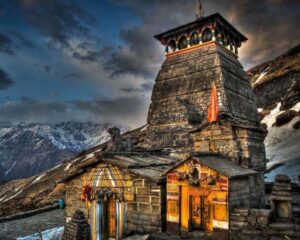
Tungnath Temple is one of the most sacred and ancient temples dedicated to Lord Shiva and holds the distinction of being the highest Shiva temple in the world. Situated at an altitude of 3,680 meters in the Garhwal Himalayas of Uttarakhand, it is part of the Panch Kedar pilgrimage sites, which also include Kedarnath, Rudranath, Madmaheshwar, and Kalpeshwar. The temple is believed to be over 1,000 years old and attracts pilgrims, trekkers, and adventure enthusiasts alike. The temple’s location on the Chandranath Parvat near Chopta offers breathtaking views and a spiritually rejuvenating atmosphere.
Key Features of Tungnath Temple
- Mythological Significance:
- According to legend, after the battle of Mahabharata, the Pandavas sought forgiveness from Lord Shiva for the sins of war. Lord Shiva, unwilling to grant forgiveness initially, transformed into a bull to evade them. At Tungnath, it is believed that Shiva’s arms emerged from the ground, marking it as one of the Panch Kedar sites.
- Tungnath Temple holds deep religious value as a place for atonement, attracting pilgrims who wish to connect with the divine.
- Unique Architecture:
- The temple features classic North Indian architecture and is built from large stones, assembled in a simple yet majestic design. The sanctum houses a swayambhu lingam (a self-manifested stone lingam) that symbolizes Shiva.
- The temple complex includes smaller shrines dedicated to Goddess Parvati, Nandi, and other Hindu deities. The rustic architecture blends seamlessly with its mountainous surroundings, enhancing the temple’s spiritual atmosphere.
- Highest Shiva Temple:
- Tungnath is the highest Shiva temple in the world and stands as a testament to human devotion and endurance, as reaching it involves a steep trek in high altitudes. This unique positioning of the temple provides sweeping views of the Himalayan peaks, including Chaukhamba, Nanda Devi, Bandarpunch, and Kedar Dome.
- Starting Point for Chandrashila Peak:
- Tungnath is a popular starting point for the trek to Chandrashila Peak, situated at an altitude of 4,000 meters. The Chandrashila trek, just 1.5 km beyond Tungnath, offers a panoramic view of the surrounding Himalayan ranges and is famous for its sunrise views. It’s a sought-after trail for trekkers looking for adventure and spirituality combined.
- Rich Flora and Fauna:
- The trek to Tungnath passes through meadows, alpine forests, and vibrant rhododendron groves. The surrounding Kedarnath Wildlife Sanctuary is home to diverse Himalayan species, making it a beautiful route for nature lovers and photographers.
Best Time to Visit Tungnath Temple
- Summer (May to June): This is the best time to visit Tungnath. During these months, temperatures are mild (ranging from 10°C to 25°C), and the paths are clear for trekking.
- Autumn (September to November): After the monsoon, the skies are clear, offering excellent visibility of the Himalayan peaks. The temperature ranges between 5°C and 20°C, making it an ideal time for trekking.
- Monsoon (July to August): The region experiences heavy rainfall, leading to landslides and slippery trails. This is not the recommended time for a visit due to safety concerns.
- Winter (December to April): The temple is closed in winter due to heavy snowfall. However, the trail up to Chopta and the snow-covered Tungnath route attract adventure enthusiasts for snow trekking.
How to Reach Tungnath Temple
- By Air:
- The nearest airport is Jolly Grant Airport in Dehradun, approximately 232 kilometers from Chopta, which is the base point for the Tungnath trek. From the airport, you can hire a taxi or take a bus to Rishikesh and then travel to Chopta.
- By Train:
- The nearest railway station is Haridwar Railway Station, about 225 kilometers from Chopta. Haridwar is well-connected to major cities like Delhi and Dehradun. From Haridwar, taxis and buses are available to reach Chopta.
- By Road:
- Chopta, the starting point for the Tungnath trek, is well-connected by road to Rishikesh, Haridwar, and Dehradun. Regular buses and taxis operate from these cities to Rudraprayag, and from there, you can reach Chopta.
- The distance from Rishikesh to Chopta is approximately 162 kilometers, and the journey offers scenic views of the mountains, valleys, and rivers of Uttarakhand.
- Trekking Route:
- From Chopta, Tungnath Temple is a 3.5-kilometer trek. The trail is a moderate climb and is well-paved, making it accessible for beginners as well as experienced trekkers.
- The trail to Chandrashila Peak is an additional 1.5 kilometers from Tungnath, and though it is steeper, it offers unparalleled views, especially at sunrise.
Travel Tips for Visiting Tungnath Temple
- Physical Fitness: Although the trek is moderate, it requires a reasonable level of physical fitness, as the altitude can make breathing more difficult. It’s advisable to prepare for the trek by doing cardio exercises.
- Clothing: Even in summer, the weather at Tungnath can be chilly, especially in the early morning and evening. Carry warm clothing and rain gear if visiting in the monsoon season.
- Accommodation: Basic accommodation is available in Chopta and nearby villages like Duggalbitta and Baniyakund. It’s advisable to book in advance, especially during the peak season.
- Local Customs: Tungnath is a revered site, so please dress modestly, respect temple protocols, and maintain silence in the temple.
- Environmental Responsibility: Carry reusable bottles, avoid littering, and be mindful of the environment, as the area is ecologically sensitive.
Tungnath Temple offers a perfect combination of spiritual fulfillment, natural beauty, and adventure. Its unique position as the highest Shiva temple, coupled with the stunning views from the nearby Chandrashila Peak, makes it a popular destination for both devotees and nature lovers. The experience of trekking through the Himalayan wilderness to reach this sacred site is truly rewarding, leaving visitors with a deep sense of peace and awe at the majesty of the mountains and the sanctity of the temple.


